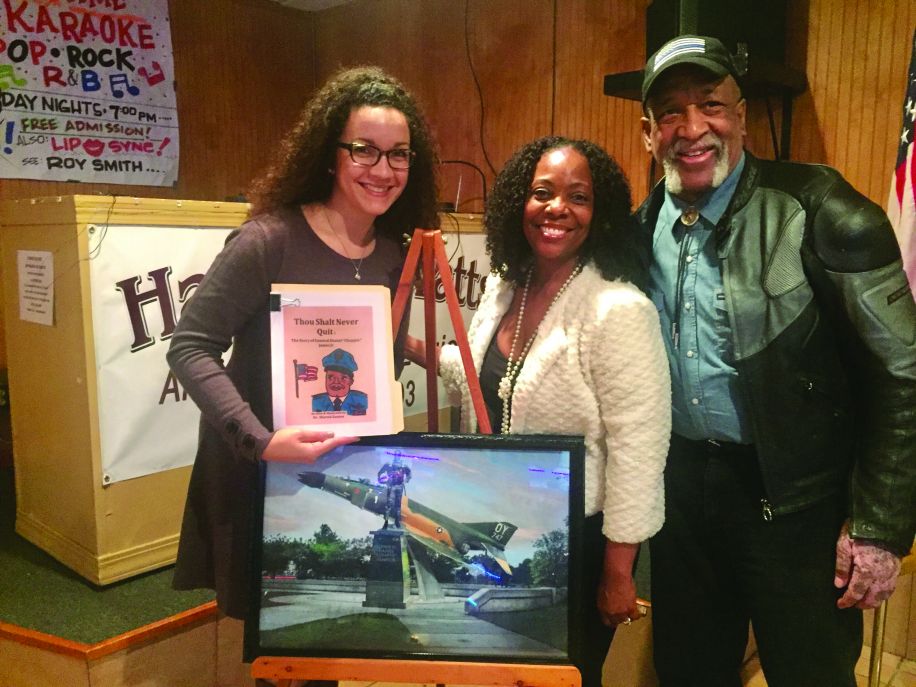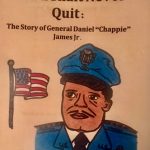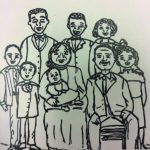By Gina Castro
Pensacola has made a name for itself in numerous ways, especially through its connection to the military. The Naval Air Station has become the primary training base for most naval flight officers, and, of course, NAS is the home of the nationally recognized Blue Angels. But what some people don’t know, is that Pensacola is also the hometown of America’s first African American Four-Star General in the armed forces, which occurred in 1975. General Daniel “Chappie” James Jr. grew up right here in Pensacola, but many people, even pensacolians, are unaware of James’ incredible accomplishments. However, children’s book author and Pensacola native Dr. Sharon Gaston is trying to change that.
Gaston was a part of the first graduating class of Booker T. Washington in 1983. Gaston’s father served 30 years in the military and retired from NAS. Gaston said that she was taught only a few times about James. Gaston’s long-time friend Clifton W. Curtis, founder and president of the Chappie James Flight Academy, suggested the idea for Gaston to write James’ story.
The book release for Thou Shalt Never Quit: The Story of General Daniel “Chappie” James Jr. is going to be at the American Legion Post and is scheduled for April 5 from 2 pm to 5 pm. After April, books may be ordered at www.lulu.com and www.docpublishing.org.

Did your background as an educator cause you to want to write children’s books?
That’s part of it, but I’ve been writing since I was probably seven years old. I was always writing stories and performing them for my family. I’d draw pictures and entertain them until they were just sick of me. My mother would say, “Oh, you are so wonderful. You could do a one-woman show! Now, please go sit down!” Anyway, as a teacher, there were certain books that I wanted to read that I couldn’t find on the shelves, and I was like “start writing!” So I started writing character education stories based on things my mom used to say to me as a child like “Clean your own house!” which means “Mind your own business!” or “Don’t burn your bridges” or “Misery loves company.”
What was it like growing up here in Pensacola and being a part of the first class to graduate from Booker T. Washington?
You know, if there’s one thing I love about Pensacola it’s the beaches. It’s the one thing I miss. I made some great friends when I was 10. We went from elementary to Workman Middle School together to Booker T. We were always together. The class from 1983 was like my backbone, you should see the support that they have been sending me. One of my classmates is a teacher in Pensacola, and she came by my house and brought a bottle of champagne and a card. I met some wonderful friends. It was fun. I learned a lot quickly with my father being on the base. We would go out to the base a lot, you know to the museums and to see the Blue Angels. But I never learned a lot about Chappie James in school.
In 1975, James became the first African American to reach the rank of four-star General in the armed forces. That must have been huge news in Pensacola. Do you remember how you first learned about James?
The first memory I have is at age 10 driving down Alcaniz Street. The only thing left of his family home, which his father built with his own hands, were the steps. Someone in the neighborhood painted “Chappie’s first steps” on there, and I thought “Who’s that? Who’s Chappie?” because no one taught us about Chappie James. No one really talked about him. I remember in the 8th grade, I had one teacher, Mr. Edwards, when I attended Workman Middle School, he talked a little bit about Chappie James. But that was it. As I got older, we used to go to a club called the Ambassador Club downtown, and they had pictures of Chappie James in there. One of my father’s friends was in the Air Force stationed at Eglin, and he talked about him. But there was never a curriculum about him or learning about him, it was just through hearsay. It was interesting doing the research and finding out all the information about him.
You have mentioned the Chappie James Museum of Pensacola a few times. Is that where you first started piecing together James’ story, or did you reach out to his family?
I did not talk to family members until after I completed the book. I didn’t even meet them until I went to the Chappie James Gala at Pensacola. We were commemorating the 100th anniversary of his birthday. His family told me that the research in the book was good. I searched on the Internet, I got books, and I read through and found information. There were a couple of people I talked to like the lady at the museum, Mrs. Robinson, who knows a lot about Chappie James, and Mr. Ellis who is the president of the board at the museum. I went on a tour there and got some information, too. So I incorporated a lot of that in my book.
How did James’ family react when they heard you had written a book?
They are endorsing the book. His youngest son, Claude, is still living. He is in Arizona. They told me the book was wonderful, and they were happy that I was keeping Chappie’s legacy alive. Claude’s daughter handles public relations, and she said that she loved the book, too, and she’s sending me a written endorsement. I also gave a copy to City Councilwoman Anne Hill, and she loved the book, too. She told me that she’d give me an endorsement.
While you were researching James, did you find something about him that really captivated you?
Oh yes! I was double-checking facts and making sure it was true because some of the research doesn’t talk about Chappie. He was expelled from Tuskegee before he was to graduate from the university because he was fighting. Some of the research I found said he graduated when he was supposed to. So, I called Tuskegee University to confirm what’s true, and they said that he was suspended for fighting and that he didn’t receive a degree until almost 25 years later. I thought that this was a good piece for character education for children because it shows that you can turn your life around and live a life of dignity and self worth. He definitely did it. He was self motivated and didn’t want to disappoint his family. That’s something that stuck out to me. He had two months left before graduating. It’s amazing.
You have written dozens of children’s books throughout the years, but why did you decide to tell James’ story in the form of a children’s book?
I love reading children’s books because you learn so much from reading children’s books. Children need to learn about him. They need to have something that they can read at their level. I targeted children aged 8 to 12. Even if it’s a good read-aloud book for teachers or parents, I wanted students to be able to pick it up and read it. Older students as well as adults can pick it up and enjoy it. There are questions in the back that they can use for class discussions with teachers to really do that close reading and understand the nuances of the story. I also added a glossary so that they can understand vocabulary. I think children need to be able to hear this story – especially young African American children in Pensacola – to see a role model like this was in their hometown and is being honored. I don’t think a lot of people even know about the museum on Alcaniz Street. I would like to get in touch with someone from the school board so that I can give them a copy and see if it can be incorporated in the school system as a part of social studies or something. They can read it and go to the museum to learn more about him.
You drew the illustrations for this book as well as wrote it. Did you have any inspiration for the illustrations of this book?
S: Yes, I always do illustrations for my books. I tell my students that my drawings aren’t the best, but they’re mine. If you can make shapes, you can make a picture! I was thinking about my nephews as I was drawing. I looked at pictures of him and thought to mimic that and see what I could do. I used pictures of Chappie like one in particular where he was getting his fourth star and it was Chappie and his wife, Dorothy, and the oldest son, Daniel III. I looked at that picture and thought “Okay, let me draw this and make it the best that I can.” I’m proud of myself. I will say that, I’m proud of myself.



